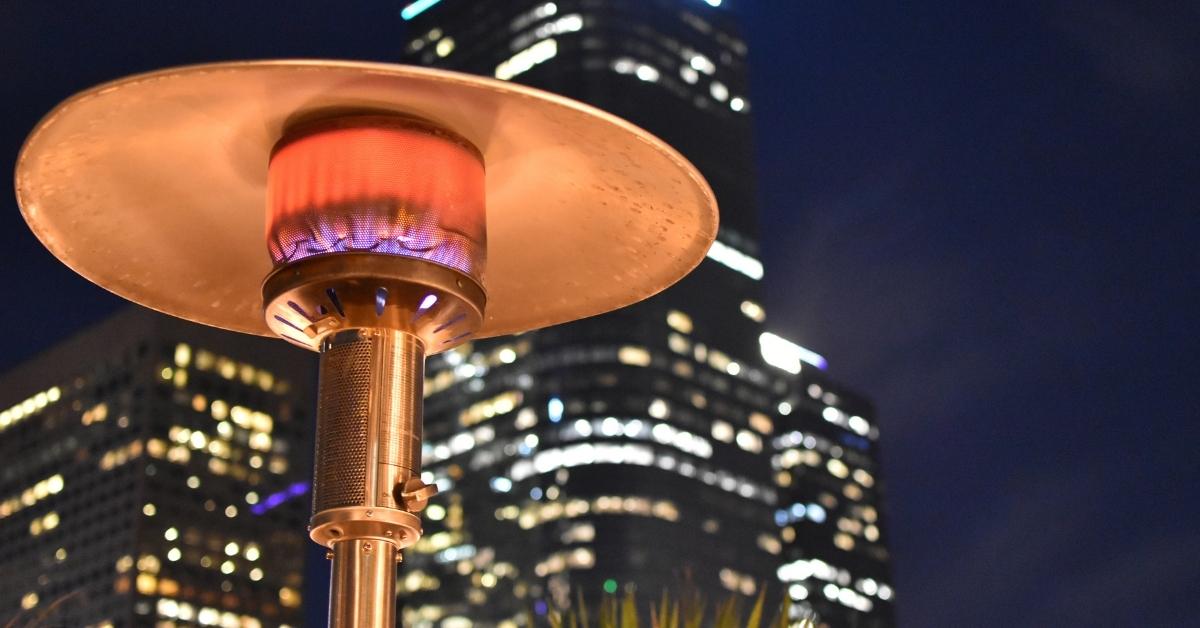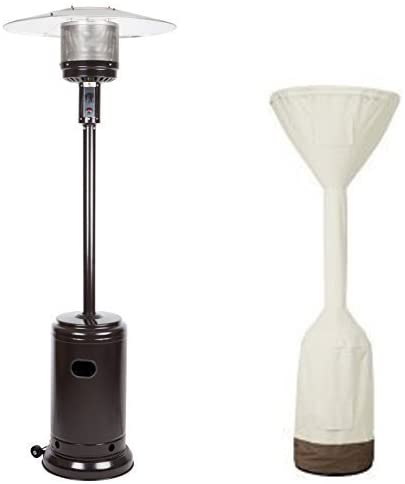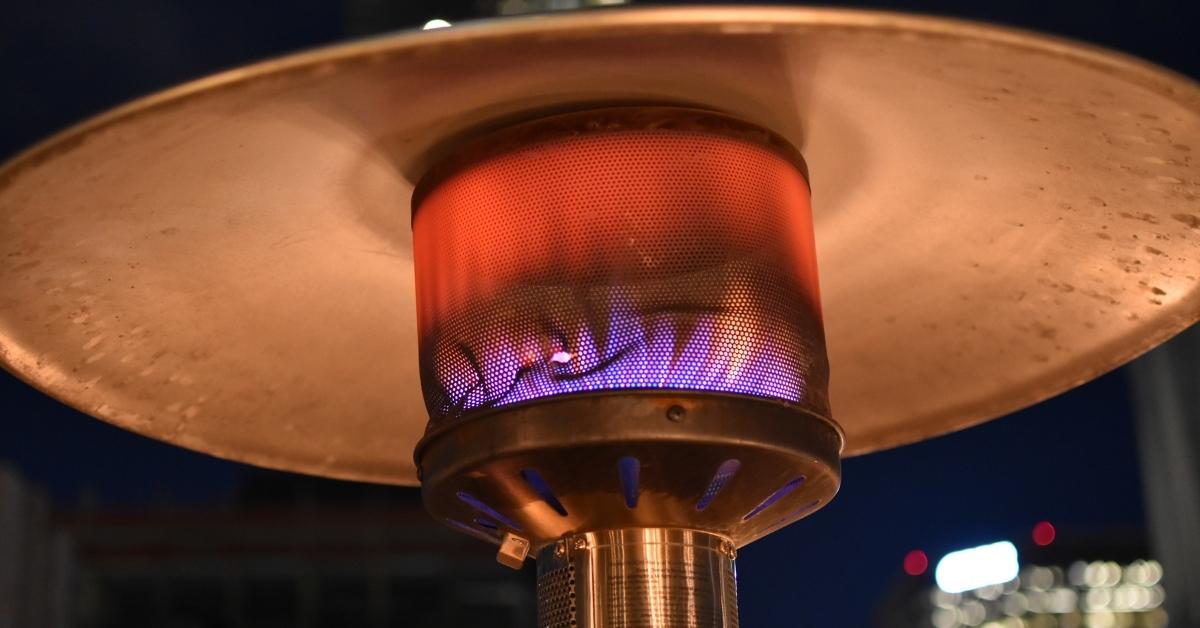It used to be the first cold snap that was a signal to put away the patio furniture and say good-bye to lounging on the lanai. Patio space heaters are a piece of modern technology that has changed all that, and now we can use our outdoor spaces well into weather that generally would be too uncomfortable.
The best Tabletop patio heater is the Havana Bronze Commercial Patio Heater.
This unit produces 46,000BTU’s of dependable gas heat. With its piezo starter, it lights quickly and easily, and the durable, powder-coated finish will fit in with just about any decor.
Plus, based on tabletop patio heater reviews, this unit ranks among the top units on the market.
How to choose the right tabletop patio heater?
When choosing a patio heater, you should consider a couple of different things. Even as much heat as these heaters produce, you are still outdoors, and you won’t turn a chilly evening into a hot night at the beach, so temper your expectations.
Plus, heat rises, so most of the heat will escape upward unless you have a covered patio or lanai. That said, patio heater reviews for this model say you can definitely feel the heat from as far as nine feet away from the unit.
After assembling the unit and connecting your gas tank (a 20 lb. LP gas tank that is not included with the unit, but that can be easily found at most home and garden, hardware stores, or online), the unit turns on at the push of a button with the piezo ignitor.
There is a large heat control dial to increase or decrease the heat output from the heater as well as turn the unit completely off. For safety, a tilt switch will automatically turn the unit off if it is tipped over.
Better than a fire pit, this heater will produce heat without smoke or open flame and is whisper quiet. The unit can be moved to wherever you want it or for easy wheeling into storage with the wheel assembly. The heating elements are located at the top of the unit, and a heat shield is used to reflect heat back downward.
The Amazon Basics Havana Bronze Commercial Patio Heater heats using the efficiency of radiant heating, so there are no blowers or fans to break or cause excessive noise. Because it uses radiant heating, the heat is distributed evenly around the unit, producing few, if any, cold spots.
The stainless steel construction makes this the best patio heater in terms of durability. The powder-coated finish will last a lifetime and will always look its best with minimum care. The heater has a bronze finish which will fit into almost all patio decors.
When assembled, the unit stands approximately seven feet, five inches, and the base is eighteen inches in diameter. You can use sand or water to weigh the base down, so the unit is harder to tip over should something accidentally bump it or if the wind is blowing strong.
If you enjoy your patio and want to be able to extend the time you can use it, then this is the heater around. Quite, attractive, top-rated, efficient are all adjectives to describe this great unit.
Let’s dive into some technical aspects and specifications of the patio tabletop heaters that you need to know before you buy them.
Patio tabletop heaters specifications, advantages and disadvantages, and more:
What is the structure of a Patio Heater?
Patio heaters are also known as gas heaters and radiant heaters. In order to ensure optimal heat radiation, the devices are adjustable in height.
Since there are different types of gas heaters, the structure is also slightly different. However, all models have a metal or glass grille to protect against burns. This grid is built around the flame.
How does a tabletop patio heater work, and what are the advantages and disadvantages of using it?
Gas-powered patio heaters are among the classic heating devices, can be used flexibly, and, in addition to providing heat, can also look good when, for example, a flame can be seen.
Like a wood fire in a fireplace, gas heaters work with convection heat (warming the ambient air). In order to generate this heat, gas is first ignited, regardless of whether it is a patio heater or a gas torch.
The resulting gas flame heats a radiating element, after which the resulting heat is directed into the environment by a reflector built behind it. The gas combustion heats the ambient air over the solid, thus creating an overall pleasant, domestic atmosphere.
Advantages
- Good heat results outdoors
- Heat can be generated in a targeted manner.
- Models are offered with drive types such as electricity and gas so that they can be used flexibly.
- The desired temperature can be set individually
- Very safe when used as directed
- Independent of external power supply
- Excellent range
- Automatic shutdown function
- Cozy ambiance through visible flames
- Easy to use
Disadvantage
- The risk of injuries for individuals when accidentally touched during operation.
- Energy guzzler despite power control
- not environmentally friendly
- It cannot be used indoors
- Not noiseless and odorless
How much gas does a patio heater use?
Gas Consumption of a tabletop patio heater
According to the rule of thumb, a gas heater consumes an average of around 0.334kg of gas per hour. With larger patio heaters, the consumption increases to approx. 0.6kg/h.
In addition to size, however, other factors are also relevant for gas consumption.
For example:
- a defective gas supply
- outside temperatures too low
- a defective heater or
- badly filled bottles
- Significantly influence or increase gas consumption.
The gas bottles, which are usually filled with propane gas, are usually used in “domestic” use in the 5kg or 11kg version and thus, depending on the heating output and the model of the heater, can last from almost 10 hours to 20 or in some cases even up to Giving off the heat for 60 hours.
What do I have to consider when it comes to the safety of patio heaters? How safe is a gas heater?
Without exception, the safety precautions for patio heaters should be carefully observed in order to rule out a possible fire hazard. Regardless of the gas or infrared heating system, when buying a gas heater, you should first of all – always make sure that the device is USA compliance or CE-certified and, especially after prolonged use, that you carry out regular maintenance. Ideally – every two years at the latest – by a specialist.
The following applies to every type of patio heater:
- Keep children and pets away from tabletop patio heaters
- Carefully assemble the radiant heater according to the instructions for use and check the lines so that there are no sealing defects
- Always keep a safe distance from easily flammable objects
- Installation on a level, stable surface and protect against possible knocks so that the heater cannot tip over or fall
- After switching off the heater, it is still hot!
Safety, especially with gas heaters
For increased safety, there should be an ignition fuse on your radiant heater so that the undesired escape of gas is prevented. The lowest power should always be set during commissioning. If necessary, you can always get spare parts from a specialist retailer.
Use in closed rooms is excluded. This also applies to tents, except (!) They are very spacious, adequately ventilated catering tents. However, a safety distance of at least two meters above and one meter next to the radiant heater must be guaranteed.
In addition, a gas heater may only be set up in such a way that any escaping gas cannot get into the air or light shafts. Due to the fact that liquid gas is heavier than air, it can create an explosive combination in these conditions. Setting up the patio heater under low-hanging awnings should be avoided at all costs due to the high temperatures above it.
Most of the gas heaters are equipped with an automatic switch-off function to prevent an explosion if they tip over. So when buying your heater, it is advisable to make sure that it is available.
What should I look for when choosing a tabletop patio heater?
When choosing a tabletop patio heater, consider the heating capacity, fuel type, safety features, and design. Look for models with adjustable heat output, safety shut-off features, and a stable base to prevent tipping.
What fuel types are available for tabletop patio heaters?
Tabletop patio heaters are available in a range of fuel types, including propane, natural gas, and electric. Propane and natural gas heaters are ideal for outdoor use, while electric heaters are best suited for indoor or covered patio areas.
Can tabletop patio heaters be used indoors?
Electric tabletop patio heaters are safe for indoor use, but propane and natural gas heaters should only be used outdoors due to the risk of carbon monoxide poisoning.
How much heat output do I need from my tabletop patio heater?
The amount of heat output you need from your tabletop patio heater will depend on the size of the area you wish to heat. Generally, a heater with 10,000 BTUs (British Thermal Units) is suitable for heating a small patio table or seating area.
Are tabletop patio heaters expensive to operate?
The operating cost of a tabletop patio heater will depend on the fuel type and heating capacity. Electric heaters are generally the most cost-effective to operate, while propane and natural gas heaters require the purchase of fuel. However, the cost of operation may be offset by the increased comfort and enjoyment of your outdoor living space during colder months.






